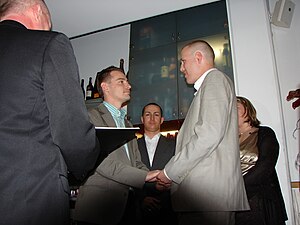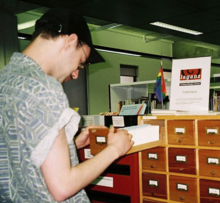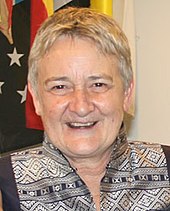
Coming out of the closet, often shortened to coming out, is a metaphor used to describe LGBTQ people's self-disclosure of their sexual orientation, romantic orientation, or gender identity.
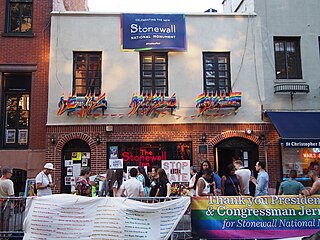
The LGBTQ community is a loosely defined grouping of lesbian, gay, bisexual, and transgender individuals united by a common culture and social movements. These communities generally celebrate pride, diversity, individuality, and sexuality. LGBTQ activists and sociologists see LGBT community-building as a counterweight to heterosexism, homophobia, biphobia, transphobia, sexualism, and conformist pressures that exist in the larger society. The term pride or sometimes gay pride expresses the LGBT community's identity and collective strength; pride parades provide both a prime example of the use and a demonstration of the general meaning of the term. The LGBT community is diverse in political affiliation. Not all people who are lesbian, gay, bisexual, or transgender consider themselves part of the LGBT community.
Takatāpui is a Māori language term that is used in a similar way to LGBT. When speaking Māori, LGBT people of any culture are referred to as takatāpui. In English, a takatāpui person is a Māori individual who is gay, lesbian, bisexual, or transgender (LGBT).

LGBTQ culture is a culture shared by lesbian, gay, bisexual, transgender, and queer individuals. It is sometimes referred to as queer culture, while the term gay culture may be used to mean either "LGBT culture" or homosexual culture specifically.
Ramon Te Wake is a New Zealand trans woman documentarian, singer-songwriter and television presenter. Her first presenting job was for Māori Television, where she was one of three people fronting Takatāpui, which is Maori Television's first ever LGBT show.
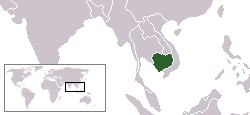
Lesbian, gay, bisexual, and transgender (LGBTQ) people in Cambodia face legal challenges not experienced by non-LGBT residents. Although same-sex sexual activity is legal in Cambodia, it provides no anti-discrimination protections for LGBT people, nor does it prohibit hate crimes based on sexual orientation and gender identity.

New Zealand lesbian, gay, bisexual, and transgender (LGBT) rights are some of the most extensive in the world. The protection of LGBT rights is advanced, relative to other countries in Oceania, and among the most liberal in the world, with the country being the first in the region to legalise same-sex marriage.
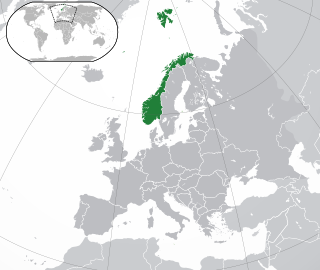
Lesbian, gay, bisexual, and transgender (LGBTQ) people in Norway have the same legal rights as non-LGBT people. In 1981, Norway became one of the first countries in the world to enact an anti-discrimination law explicitly including sexual orientation. Same-sex marriage, adoption, and assisted insemination treatments for lesbian couples have been legal since 2009. In 2016, Norway became the fourth country in Europe to pass a law allowing the change of legal sex for transgender people based on self-determination. On 1 January 2024, conversion therapy became legally banned within Norway.

Lesbian, gay, bisexual, transgender, intersex, non-binary and otherwise queer, non-cisgender, non-heterosexual citizens of El Salvador face considerable legal and social challenges not experienced by fellow heterosexual, cisgender Salvadorans. While same-sex sexual activity between all genders is legal in the country, same-sex marriage is not recognized; thus, same-sex couples—and households headed by same-sex couples—are not eligible for the same legal benefits provided to heterosexual married couples.
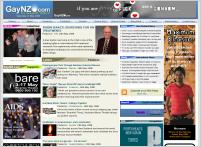
GayNZ.com is a Lesbian, Gay, Bisexual, and Transgender community website for New Zealand.

Lesbian, gay, bisexual, and transgender (LGBT) people in Mongolia face legal and social challenges not experienced by non-LGBT people, though there have been substantial improvements since the 1990s. Homosexuality was criminalised in Mongolia in 1961 through its Criminal Code. Following the Mongolian Revolution of 1990 and the peaceful transition to a democracy, homosexuality was legalised and awareness about LGBT people has become more prevalent. Hate crimes on the basis of sexual orientation and gender identity result in additional legal penalties. Hate speech based on these two categories has been outlawed in the country since 1 July 2017. Households headed by same-sex couples are, however, not eligible for the same legal protections available to opposite-sex couples.
The ordination of lesbian, gay, bisexual and/or transgender (LGBT) clergy who are open about their sexuality or gender identity; are sexually active if lesbian, gay, or bisexual; or are in committed same-sex relationships is a debated practice within some contemporary Christian denominations.

The demographics of sexual orientation and gender identity in the United States have been studied in the social sciences in recent decades. A 2022 Gallup poll concluded that 7.1% of adult Americans identified as LGBT. A different survey in 2016, from the Williams Institute, estimated that 0.6% of U.S. adults identify as transgender. As of 2022, estimates for the total percentage of U.S. adults that are transgender or nonbinary range from 0.5% to 1.6%. Additionally, a Pew Research survey from 2022 found that approximately 5% of young adults in the U.S. say their gender is different from their sex assigned at birth.

Carmen Rupe, was a New Zealand drag performer, brothel keeper, anti-discrimination activist, would-be politician and HIV/AIDS activist. Carmen Rupe was New Zealand's first drag queen to reach celebrity status. She was a trans woman.

The following outline offers an overview and guide to LGBTQ topics:
This is a timeline of notable events in the history of non-heterosexual conforming people of African ancestry, who may identify as LGBTIQGNC, men who have sex with men, or related culturally specific identities. This timeline includes events both in Africa, the Americas and Europe and in the global African diaspora, as the histories are very deeply linked.

Elizabeth Anne Kerekere is a New Zealand politician and LGBTQ activist and scholar. She was elected a member of parliament for the Green Party in 2020, but resigned from the Greens on 5 May 2023, following allegations of bullying within the party. Kerekere remained in parliament as an independent until the 2023 election.

